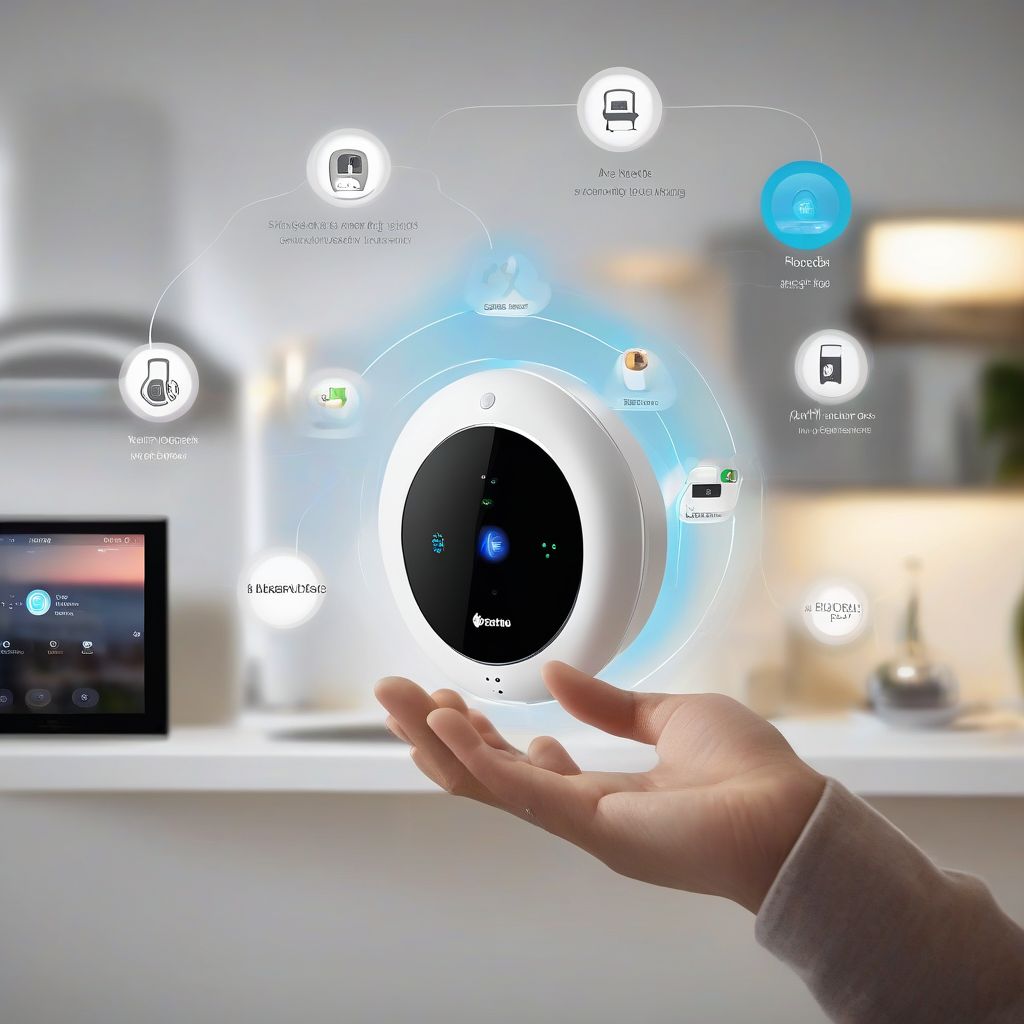Remember the days when a “smart home” sounded like something straight out of a sci-fi movie? Now, it’s easier than you might think to turn that futuristic dream into your everyday reality. Whether you’re a tech enthusiast or just dipping your toes into the world of connected living, this guide will walk you through everything you need to know about smart home setups.
Why Choose a Smart Home?
Before we dive into the “how-to,” let’s talk about the “why.” Smart homes offer a blend of comfort, convenience, and control that can truly elevate your living experience. Imagine:
- Effortless Control: Adjusting your thermostat, lighting, and even appliances with just your voice or a tap on your phone.
- Enhanced Security: Keeping a watchful eye on your property remotely and receiving instant alerts about any unusual activity.
- Energy Savings: Optimizing your energy consumption by automatically adjusting settings based on your routines and preferences.
Smart Home Setup: A Step-by-Step Guide
Ready to transform your house into a haven of connected living? Let’s break down the process:
1. Define Your Smart Home Vision
Start by envisioning how you want your smart home to work for you.
- What are your priorities? Are you most interested in enhanced security, energy efficiency, or entertainment upgrades?
- Which areas of your home do you want to automate? Focus on the spaces where smart technology would make the biggest impact.
 Smart Home Hub and Devices
Smart Home Hub and Devices
2. Choose Your Smart Home Ecosystem
The heart of your smart home lies in its ecosystem. This typically involves a central hub or platform that connects and controls all your devices. Some popular options include:
- Amazon Alexa: Known for its user-friendly interface and vast device compatibility.
- Google Home: Seamless integration with Google services and a strong focus on voice control.
- Apple HomeKit: A great choice for Apple users, prioritizing privacy and a sleek, intuitive design.
- Samsung SmartThings: A versatile platform that works with a wide range of devices and offers robust automation features.
Pro Tip: When selecting an ecosystem, consider factors like your budget, technical comfort level, and the devices you plan to use. Research compatibility to ensure all your chosen devices can seamlessly “talk” to each other.
3. Start with the Essentials
You don’t need to go all-in on every smart gadget right away. Begin with a few essential devices that align with your priorities:
- Smart Speaker (like Amazon Echo or Google Nest): Your voice-activated command center for controlling devices, setting reminders, and getting information.
- Smart Lighting: Easily control the ambiance of your home while saving energy.
- Smart Thermostat (like Nest Learning Thermostat): Optimize your heating and cooling for maximum comfort and energy efficiency.
- Smart Security Cameras: Keep an eye on your property and loved ones, from anywhere.
4. Expand Your Smart Home Gradually
Once you’re comfortable with your initial setup, gradually incorporate more devices that enhance your lifestyle:
- Smart Appliances: From refrigerators that help you create grocery lists to ovens you can preheat remotely, smart appliances add a new level of convenience to your kitchen.
- Smart Plugs: Turn ordinary devices into smart ones, allowing you to control them remotely or on a schedule.
- Smart Locks: Enjoy keyless entry, grant access to guests remotely, and receive notifications when someone enters or exits your home.
- Robot Vacuum: Let technology handle the chores while you relax.
5. Master the Art of Automation
The true magic of a smart home lies in its ability to automate tasks and create personalized experiences. Most smart home ecosystems offer features like:
- Routines: Create customized actions that occur automatically based on triggers like time of day, your location, or a specific voice command. For example, you could set a “Good Morning” routine that turns on your lights, adjusts the thermostat, and starts brewing your coffee.
- Scenes: Group multiple devices together to create specific moods or settings. For example, a “Movie Night” scene could dim the lights, lower the blinds, and turn on your streaming device.
Pro Tip: Explore the automation features offered by your chosen ecosystem to unlock the full potential of your smart home.
6. Prioritize Security and Privacy
As you build your connected home, remember that with increased connectivity comes a responsibility to safeguard your data:
- Choose strong, unique passwords for all your devices and accounts.
- Enable two-factor authentication whenever possible for an extra layer of security.
- Regularly update your devices’ firmware to benefit from the latest security patches.
- Carefully review the privacy policies of the devices and ecosystems you choose.
- Better inside and out – Entertainment is more immersive with spatial audio and an 8" HD touchscreen. Video calling is crisper with high-quality sound and a 13 MP camera. And your home is more connected than ever with the built-in smart home hub.
- Vibrant sights, full sound – Content on Prime Video, Netflix, Fire TV Channels, and more comes to life with an HD display and room-filling spatial audio. Ask Alexa to stream Amazon Music, Apple Music, or Spotify. Subscriptions for some services required.
- Easiest way to make your home a smart home: Wirelessly connect and control a huge range of smart devices - over 5,000 are available from dozens of brands - including voice assistants, lights & switches, speakers, cameras, sensors and more
- Automate connected devices: Any device you connect can be included into automations which can be intelligently managed. Now many automations work locally even when internet service is disrupted.
- Introducing Echo Hub — An easy-to-use Alexa-enabled control panel for your smart home devices—just ask Alexa or tap the display to control lights, smart plugs, camera feeds, and more.
- Streamline your smart home — Customize the controls and widgets, displayed on your dashboard to quickly adjust devices, view cameras, start routines, and more.
- 💡 EASIEST WAY TO GET STARTED WITH HOME ASSISTANT - With Home Assistant already installed, it only requires plugging the included power supply and Ethernet cable to get started.
- ✅ OFFICIAL - This official Home Assistant hardware is built and supported by Nabu Casa, the team driving the development of Home Assistant.
- Premium sound – Rich, detailed sound that automatically adapts to any room. Supports lossless HD audio available on select streaming services such as Amazon Music HD.
- Voice control your music – Stream songs from Amazon Music, Apple Music, Spotify, SiriusXM, and more. HD requires a compatible music streaming service.
- Alexa can show you even more - With a 10.1" HD screen that’s designed to move with you, video calls, recipes, and shows are always in view. The speakers deliver premium, directional sound.
- Stay in frame - Video call friends and family or take a picture while the 13MP camera with auto-framing and motion keeps you front and center.
- With the Hubitat Elevation C-8, you can easily control and automate lights, locks, switches, dimmers, blinds, thermostats, sensors, button controllers, and smart plugs, all locally processed for speed, reliability, and privacy. The hub works with a variety of devices and platforms, including Amazon Alexa, Google Home, HomeKit, and more. Hubitat C-8 supports Zigbee and Z-Wave and Matter protocols, providing you with a wide range of compatible smart home devices. The model C-8 also adds Wi-Fi in addition to an ethernet connection.
- ENHANCED CAPABILITIES: The Hubitat Elevation Model C-8 is designed to seamlessly support standard Zigbee, Z-Wave, and Matter devices, as well as select Wi-Fi devices, offering versatile connectivity options for your smart home.
- VALUE BUNDLE INCLUDES: Google Nest Hub 2nd Generation with English, Spanish, French and Portuguese Global Language Compatibility so it works everywhere, Universal Power Adapter and Quick Start Guide with International Manual for Global Users
- IT WORKS EVERYWHERE Easy to use and will automatically start up in English when connecting to your device for the first time. The Nest Hub works globally with support for most languages and places internationally. And its language settings can always be changed back and forth to your preferred language anytime for international use or travel at your convenience
- [Multi-Protocol Hub with Matter Bridge] The M3 is a versatile hub supporting Aqara Zigbee and Thread devices. (Refer to Aqara's website for the list of Aqara Zigbee devices exposed to Matter). It integrates third-party devices into the Aqara Home app (currently limited to select device types, will be expanded over time). As a Matter bridge, it exposes existing Aqara Zigbee devices to Matter-compatible apps such as Apple Home. Supports up to 127 Thread/Zigbee devices (Repeaters are needed).
- [Edge Compatibilities and Local Automations] The M3 serves as an Edge Hub, prioritizing local control and automation. Upon integration, it supersedes existing Aqara hubs, shifting the automations among them to local operation (*Some cloud-based notifications still require internet). Upgrade-friendly, it supports migrating Zigbee devices from older Aqara hubs. (Reconfiguration is needed for Matter and HomeKit; Cloud integrations like Alexa retain all the configurations.)
- ✽NOTES: Aqara Hub M2 requires a secured 2.4 GHz Wi-Fi network connection. One Aqara Hub M2 can connect up to 128 Aqara devices (Zigbee repeaters required). Zigbee 3.0 Support, supports all the latest Aqara devices based on the fastest, most stable, and energy-efficient technology.
- 360° Infrared Control: Control your existing IR devices such as fans, air conditioners, TVs from any part of your room by voice and via home automations (indoor use only).
Conclusion: Embrace a Smarter, More Connected Future
Creating your ideal smart home is a journey, not a race. By taking it step-by-step, you can build a connected space that seamlessly adapts to your needs and enhances your everyday life. From energy efficiency to enhanced security and unparalleled convenience, the benefits of a smart home are vast and continue to evolve as technology advances.
What aspects of a smart home are you most excited about? Share your thoughts in the comments below! Ready to delve deeper into specific smart home setups or tutorials? Check out our related articles: Tech Upgrade Guides and Tech Setup Tutorials.










